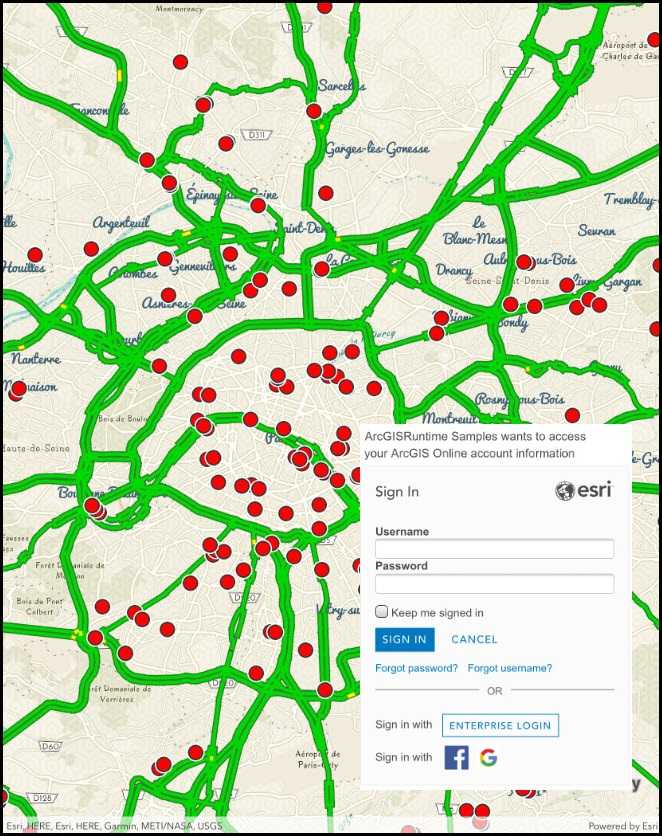Authenticate with ArcGIS Online (or your own portal) using OAuth2 to access secured resources (such as private web maps or layers).

Use case
Your app may need to access items that are only shared with authorized users. For example, your organization may host private data layers or feature services that are only accessible to verified users. You may also need to take advantage of premium ArcGIS Online services, such as geocoding or routing services, which require a named user login.
How to use the sample
When you run the sample, the app will load a web map which contains premium content. You will be challenged for an ArcGIS Online login to view the private layers. Enter a user name and password for an ArcGIS Online named user account (such as your ArcGIS for Developers account). If you authenticate successfully, the traffic layer will display, otherwise the map will contain only the public basemap layer.
How it works
- Set the
AuthenticationManager'sChallengeHandler. - Create a
ServerInfospecifying the portal URL, client ID, and redirect URL. - Register the server with the authentication manager.
- Load a map with premium content requiring authentication to automatically invoke the authentication handler.
Relevant API
- AuthenticationManager
- OAuthConfiguration
- PortalItem
- ServerInfo
Additional information
The workflow presented in this sample works for most SAML based enterprise (IWA, PKI, Okta, etc.) & social (facebook, google, etc.) identity providers for ArcGIS Online or Portal. For more information tap here. On UWP, some authentication workflows that don't support WebAuthenticationBroker may require a custom IOAuthAuthorizeHandler.
For additional information on using Oauth in your app, see the Mobile and Native Named User Login topic in our guide.
Tags
authentication, cloud, credential, OAuth, OAuth2, portal, security
Sample Code
// Copyright 2021 Esri.
//
// Licensed under the Apache License, Version 2.0 (the "License"); you may not use this file except in compliance with the License.
// You may obtain a copy of the License at: http://www.apache.org/licenses/LICENSE-2.0
//
// Unless required by applicable law or agreed to in writing, software distributed under the License is distributed on an
// "AS IS" BASIS, WITHOUT WARRANTIES OR CONDITIONS OF ANY KIND, either express or implied. See the License for the specific
// language governing permissions and limitations under the License.
using Esri.ArcGISRuntime.Security;
using System;
using System.Collections.Generic;
using System.Threading.Tasks;
using UIKit;
using Xamarin.Essentials;
namespace ArcGISRuntime.Helpers
{
internal static class ArcGISLoginPrompt
{
private const string ArcGISOnlineUrl = "https://www.arcgis.com/sharing/rest";
// - The Client ID for an app registered with the server (the ID below is for a public app created by the ArcGIS Runtime team).
public const string AppClientId = @"IBkBd7YYFHOzPIIO";
// - An optional client secret for the app (only needed for the OAuthClientCredentials authorization type).
private const string ClientSecret = "";
// - A URL for redirecting after a successful authorization (this must be a URL configured with the app).
// NOTE: to use a custom URL scheme like the one below, you need to add it to CFBundleURLSchemes in info.plist.
// For example -
// <key>CFBundleURLSchemes</key>
// <array>
// <string>my-ags-app</string>
// </array>
private const string OAuthRedirectUrl = @"xamarin-ios-app://auth";
public static async Task<bool> EnsureAGOLCredentialAsync()
{
bool loggedIn = false;
try
{
// Create a challenge request for portal credentials (OAuth credential request for arcgis.com)
CredentialRequestInfo challengeRequest = new CredentialRequestInfo
{
// Use the OAuth authorization code workflow.
GenerateTokenOptions = new GenerateTokenOptions
{
TokenAuthenticationType = TokenAuthenticationType.OAuthAuthorizationCode
},
// Indicate the url (portal) to authenticate with (ArcGIS Online)
ServiceUri = new Uri(ArcGISOnlineUrl)
};
// Call GetCredentialAsync on the AuthenticationManager to invoke the challenge handler
Credential cred = await AuthenticationManager.Current.GetCredentialAsync(challengeRequest, false);
loggedIn = cred != null;
}
catch (OperationCanceledException)
{
// OAuth login was canceled, no need to display error to user.
}
catch (Exception ex)
{
new UIAlertView("Login failed", ex.Message, (IUIAlertViewDelegate)null, "OK", null).Show();
}
return loggedIn;
}
public static void SetChallengeHandler(UIViewController controller)
{
// Define the server information for ArcGIS Online
ServerInfo portalServerInfo = new ServerInfo(new Uri(ArcGISOnlineUrl))
{
TokenAuthenticationType = TokenAuthenticationType.OAuthAuthorizationCode,
OAuthClientInfo = new OAuthClientInfo(AppClientId, new Uri(OAuthRedirectUrl))
};
// If a client secret has been configured, set the authentication type to OAuth client credentials.
if (!string.IsNullOrEmpty(ClientSecret))
{
// If a client secret is specified then use the TokenAuthenticationType.OAuthClientCredentials type.
portalServerInfo.TokenAuthenticationType = TokenAuthenticationType.OAuthClientCredentials;
portalServerInfo.OAuthClientInfo.ClientSecret = ClientSecret;
}
// Register this server with AuthenticationManager.
AuthenticationManager.Current.RegisterServer(portalServerInfo);
// Use a function in this class to challenge for credentials.
AuthenticationManager.Current.ChallengeHandler = new ChallengeHandler(PromptCredentialAsync);
// Set the OAuthAuthorizeHandler component (this class).
AuthenticationManager.Current.OAuthAuthorizeHandler = new OAuthAuthorize(controller);
}
// ChallengeHandler function that will be called whenever access to a secured resource is attempted.
public static async Task<Credential> PromptCredentialAsync(CredentialRequestInfo info)
{
Credential credential = null;
try
{
// IOAuthAuthorizeHandler will challenge the user for OAuth credentials.
credential = await AuthenticationManager.Current.GenerateCredentialAsync(info.ServiceUri);
}
// OAuth login was canceled, no need to display error to user.
catch (TaskCanceledException) { }
catch (OperationCanceledException) { }
return credential;
}
}
public class OAuthAuthorize : IOAuthAuthorizeHandler
{
// Use a TaskCompletionSource to track the completion of the authorization.
private TaskCompletionSource<IDictionary<string, string>> _taskCompletionSource;
private UIViewController _viewController;
public OAuthAuthorize(UIViewController activity)
{
_viewController = activity;
}
// IOAuthAuthorizeHandler.AuthorizeAsync implementation.
public async Task<IDictionary<string, string>> AuthorizeAsync(Uri serviceUri, Uri authorizeUri, Uri callbackUri)
{
try
{
// Create a task completion source.
_taskCompletionSource = new TaskCompletionSource<IDictionary<string, string>>();
// Start the authentication on the UI thread.
_viewController.BeginInvokeOnMainThread(async () =>
{
try
{
var result = await WebAuthenticator.AuthenticateAsync(authorizeUri, callbackUri);
_taskCompletionSource.SetResult(result.Properties);
}
catch (Exception ex)
{
_taskCompletionSource.TrySetException(ex);
}
});
return await _taskCompletionSource.Task;
}
catch (Exception) { }
// Return null if anything goes wrong with authentication.
return null;
}
}
}